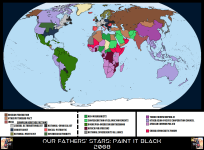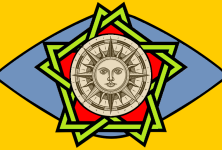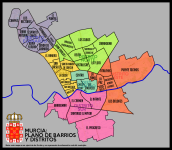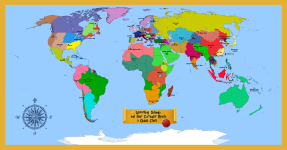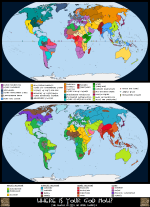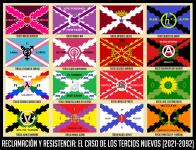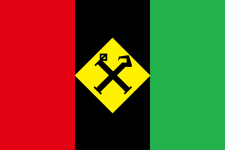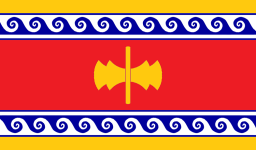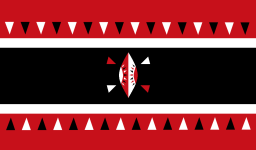SerialExperimentsHeechee
Active member
Our Father's Stars: Grace Will Lead Us Home
The third take in the Our Fathers' Stars series. In this alternate timeline, the Second American Revolution succeeded, but was hijacked by the Faith Party and the Theodomists, shaping it at its image. During the Third War on Terror, This America aggressively supported the Red Flag faction, resulting in a new form of Islamic Theodomist unity. The crises of the century proved utterly wrong those who once thought Secularism was the wave of the future. Post-liberalism has seen its influence greatly reduced, overshadowed by all forms of Dominionism and other strands of Fundamentialist revival, while Asia is liberal democracy's last stronghold.
Still, in the Revivalist world, strong differences persist, and some of the biggest ones are cross-denominational and inter-denominational. First, there's the Marxist versus the reactionary strands of Theocratic order. In the reactionary side we have the Russian Orthodox, the Green Flag Islamist regimes and the heirs of the Christian Remnant in Europe. In the Marxist side, we have the American and the Brazilian spheres of influence, with differing theological views: Brazil is closer to the Post-Millenialist roots of the movement due to its Pentecostal flavor, still considers the construction of a Christian world-state is neccesary to bring the Second Coming, and has a more populistic flavor, truer to its leftist ethos. America is more prone to collaborate with other Theodomist denominations -notably, the Red Flag Federation-, while cracking religious dissent within its borders, and its leftist policies are less radical. The New Ecumenical Patriarchate is just a collection of Orthodox Theodomists that stand defiant to the Russian schism, and that play an equidistant game with both factions. Pan-Theodomism is an offshoot movement that tries to encompass all abrahamic denominations as compatible, and that has taken hold in very few places, the UK being one of them, but also Israel, both at heart as a generational shift and as a means of survival, depending on and surrounded by Theodomist powers. Italy, meanwhile, was nearly torn apart by the tensions between the Christianist Padanians and the increasingly Theodomist Mezzogiorno, which ultimately made the paramilitary forces of the Partito Nostro to intervene with almost nobody from the general public batting an eye. North Italy is close to a war zone, and the difficulties to keep order have turned Italy into a Mafia-run police state.

The third take in the Our Fathers' Stars series. In this alternate timeline, the Second American Revolution succeeded, but was hijacked by the Faith Party and the Theodomists, shaping it at its image. During the Third War on Terror, This America aggressively supported the Red Flag faction, resulting in a new form of Islamic Theodomist unity. The crises of the century proved utterly wrong those who once thought Secularism was the wave of the future. Post-liberalism has seen its influence greatly reduced, overshadowed by all forms of Dominionism and other strands of Fundamentialist revival, while Asia is liberal democracy's last stronghold.
Still, in the Revivalist world, strong differences persist, and some of the biggest ones are cross-denominational and inter-denominational. First, there's the Marxist versus the reactionary strands of Theocratic order. In the reactionary side we have the Russian Orthodox, the Green Flag Islamist regimes and the heirs of the Christian Remnant in Europe. In the Marxist side, we have the American and the Brazilian spheres of influence, with differing theological views: Brazil is closer to the Post-Millenialist roots of the movement due to its Pentecostal flavor, still considers the construction of a Christian world-state is neccesary to bring the Second Coming, and has a more populistic flavor, truer to its leftist ethos. America is more prone to collaborate with other Theodomist denominations -notably, the Red Flag Federation-, while cracking religious dissent within its borders, and its leftist policies are less radical. The New Ecumenical Patriarchate is just a collection of Orthodox Theodomists that stand defiant to the Russian schism, and that play an equidistant game with both factions. Pan-Theodomism is an offshoot movement that tries to encompass all abrahamic denominations as compatible, and that has taken hold in very few places, the UK being one of them, but also Israel, both at heart as a generational shift and as a means of survival, depending on and surrounded by Theodomist powers. Italy, meanwhile, was nearly torn apart by the tensions between the Christianist Padanians and the increasingly Theodomist Mezzogiorno, which ultimately made the paramilitary forces of the Partito Nostro to intervene with almost nobody from the general public batting an eye. North Italy is close to a war zone, and the difficulties to keep order have turned Italy into a Mafia-run police state.



